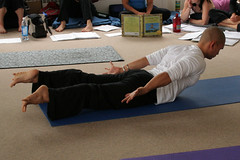| The lumbar region is most affected by sitting. (Photo credit: Wikipedia) |
Once you have back problems you must remain conscious all through the day of how you stand, sit and lie down. Here are a few general guidelines:
- Always sleep on a firm (not necessarily hard) bed, with a flat pillow under your head and a thicker one under your knees. This will help the spine to reposition and adjust itself.
- Do not wear high heels as this promotes lumbar lordosis and throws the spine out of balance.
- When experiencing pain (even mildly) do not go in for break-dancing, strenuous aerobics, jogging, running or anything where you need to bounce or jiggle. Guarded activity is the key here.
You may wish to consult a chiropractor and see if they can be of help - in some cases of acute pain, a chiropractic adjustment can provide immediate relief.
When the pain is acute and you can neither sit nor stand in comfort, rest in bed, apply ice packs to the area regularly, take whatever anti-inflammatory or analgesic medications your physician prescribes, and wait until the pain is milder before attempting any yoga postures.
| Diamond Pose - Vajrasana (Photo credit: Wikipedia) |
* The Diamond Posture (Vajrasana)
Kneel on a thick carpet or blanket with your knees close together. Sit back on your heels and stretch up from your hips, balancing your head well so that a line drawn through ear, shoulder, elbow and hip would be straight. You should sit often in this posture for greatest benefits.
| Locust Pose (Salabhasana) A (Photo credit: dejahthoris) |
Most yoga students are familiar with this posture. Lie flat, face down, chin on floor. Make your hands into fists and push them either under your thighs to help the lift, or place them alongside your body. Exhale and lift legs from your hips, tightening your buttocks and stretching your legs up and back. Hold position for as long as possible, exhale, return to starting posture and repeat.
| Cobra Pose - Bhujangasana (Photo credit: myyogaonline) |
Cobra Pose (Bhujangasana)
Lie face down, legs stretched back, buttocks tightened and knees pulled back. Place hands just below shoulders, exhale and lift head, then chest, shoulders and torso, pushing down from your pelvis and straightening your arms. From the back of your head to your tailbone, your body should be curved back. Push shoulders back and down. Push head back more. Stay like this as long as possible with normal breathing. Come down very slowly, and relax.
| Seated twist (Bharadvajasana) (Photo credit: yogamama.co.uk) |
Kneel on the floor and sit back, bringing both feet to the right of your hips. Straighten your right arm, bring it across your body and turn to the left. Place your hand, palm down under your left knee. Exhale, turn your body more to the left and clasp your right elbow with your left hand, from the back. Turn your head and gaze over your right shoulder. Fold position for a few breaths and then twist and look back over your left shoulder. Shoulders should be at right angles to the body. Come back to starting position and repeat on other side. You should do this posture once every hour if you have lower back pain.
Check back later this week for some more yoga postures that can be of great benefit to frequent computer users, and others who spend much of their day sitting.






No comments:
Post a Comment